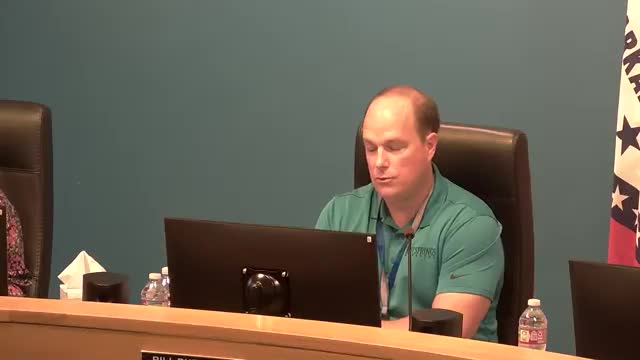Park Service environmental review pauses Spring Street sewer phase; board asked to approve negative change order
October 01, 2025 | Hot Springs City, Garland County, Arkansas
This article was created by AI summarizing key points discussed. AI makes mistakes, so for full details and context, please refer to the video of the full meeting. Please report any errors so we can fix them. Report an error »

City staff told the Hot Springs Board of Directors Oct. 7 that the Spring Street gravity sewer relocation project must pause for environmental studies requested by the National Park Service, and staff recommended removing one contracted phase from Diamond Construction Co.'s scope.
City Engineer Gary Carnahan explained that Schedule 3 of the contract requires environmental work on National Park Service property that was not anticipated in bid documents. "When we met with the National Park Service they are requesting environmental studies that we did not anticipate," Carnahan said. To avoid starting construction that may need to be reworked, staff recommended a negative change order removing Schedule 3, which represents $2,761,003.92 of the contractor's contract value.
Carnahan said Diamond Construction will continue work on the other contract schedules; the negative change order terminates only the Schedule 3 portion before work starts. He estimated environmental studies could take at least a year and said the current plans and designs would likely remain usable after the pause, subject to the outcome of archaeological and environmental reviews. Staff said there will be some cost savings in reduced engineering inspection hours because inspection for the removed schedule would not be required.
Board members asked whether delaying Schedule 3 would create sewer overflows or other immediate system impacts. Staff said they do not expect additional overflows as a direct result of pausing Schedule 3 because the problematic overflow appears to be caused by downstream restrictions that will be addressed in other parts of the contract. Staff also confirmed that Diamond had purchased bonding and insurance for the full amount and the city will compensate the contractor for about $50,000 of those incurred costs.
No final vote was taken at the agenda meeting; staff will present the negative change order for formal action at the regular Board meeting. Staff said the environmental work will involve repeated archaeological digs (about every 10 meters) and that the National Park Service review process is the reason for the delay.
City Engineer Gary Carnahan explained that Schedule 3 of the contract requires environmental work on National Park Service property that was not anticipated in bid documents. "When we met with the National Park Service they are requesting environmental studies that we did not anticipate," Carnahan said. To avoid starting construction that may need to be reworked, staff recommended a negative change order removing Schedule 3, which represents $2,761,003.92 of the contractor's contract value.
Carnahan said Diamond Construction will continue work on the other contract schedules; the negative change order terminates only the Schedule 3 portion before work starts. He estimated environmental studies could take at least a year and said the current plans and designs would likely remain usable after the pause, subject to the outcome of archaeological and environmental reviews. Staff said there will be some cost savings in reduced engineering inspection hours because inspection for the removed schedule would not be required.
Board members asked whether delaying Schedule 3 would create sewer overflows or other immediate system impacts. Staff said they do not expect additional overflows as a direct result of pausing Schedule 3 because the problematic overflow appears to be caused by downstream restrictions that will be addressed in other parts of the contract. Staff also confirmed that Diamond had purchased bonding and insurance for the full amount and the city will compensate the contractor for about $50,000 of those incurred costs.
No final vote was taken at the agenda meeting; staff will present the negative change order for formal action at the regular Board meeting. Staff said the environmental work will involve repeated archaeological digs (about every 10 meters) and that the National Park Service review process is the reason for the delay.
View full meeting
This article is based on a recent meeting—watch the full video and explore the complete transcript for deeper insights into the discussion.
View full meeting
